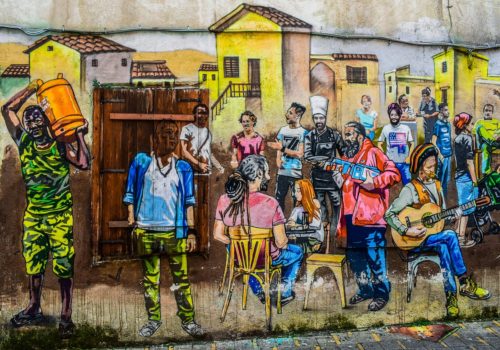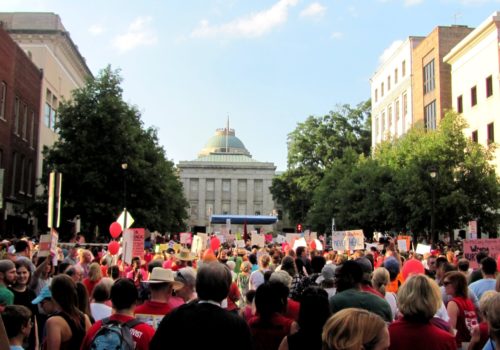Download PDF: McBride, Bestowing Meaning
In my work thus far, I have explored the relationship between theology and ethnography intuitively, rather than following a formal methodology. Therefore, I would like to contribute to the conversation in this journal simply by sharing how theology and ethnography have been connected in my dissertation and present book project, The Church for the World: A Theology of Public Witness.1 The hope is that by doing so, I will not only begin to articulate in a more precise manner how I arrived at this interconnection but also may help the reader imagine a mutually beneficial relationship between the two.
My attentiveness to the interconnection of theology and ethnography has autobiographical, as well as academic, roots. I entered graduate school impassioned and disoriented from two years working in a Washington D.C. inner-city ministry called the Southeast (or “Little”) White House, and I brought with me concerns and questions about the church’s identity and mission in society that I could barely articulate. I readily recognized the need for collaboration between theologians and practitioners because I had begun to wrestle theologically with issues surrounding privilege, poverty, injustice, race, and human flourishing while working at the Southeast White House. I became a graduate student in large part in an attempt to speak theologically to the realities I had encountered, but I also was determined to maintain my practitioner status and speak out of that formation. I went to the University of Virginia to work with the Project on Lived Theology because this initiative was promoting sustained conversation and collaboration between academic theologians and scholars of religion on the one hand and pastors, practitioners, and activists on the other.
Through my work with the Project on Lived Theology, I discovered an organic connection between theology and ethnography. The Project operates out of the rationale that theologians and practitioners need one another to engage more fully the task of cultivating just and redemptive communities, so Lived Theology creates space for conversations between these two groups. Literally, the Project invites conversation by organizing workgroups and institutes around a particular topic of common concern. Methodologically, “lived theology” creates conversation between theology and ethnography by demonstrating how academic—and, in particular, philosophical—theology may be expressed concretely “in the language of reality,” as the German philosophical theologian Dietrich Bonhoeffer put it.2 That is to say, the Project takes seriously the concrete social implications of academic theology. As a scholarly practice, “lived theology” suggests that academics may gain theological insight by reading a community-building ministry in a similar manner to a theological text; reciprocally, the ministry may gain self-understanding when a scholar presents a theological narrative of its work, drawing from the myriad resources within traditions of philosophical theology, theological ethics, and related disciplines. (I recognize that there are good reasons to move beyond Paul Ricoeur’s metaphor of text since it does not adequately capture the performative quality of lived communities. However, I refer to communities as theological texts here in order to emphasize that the knowledge gained from them may be placed on the same authoritative ground as philosophical or theological works, within a subfield where abstract discourse is the norm.)
The mutually beneficial dynamic mentioned above played out in my first graduate seminar paper in Charles Marsh’s course, “The Kingdom of God in America,” where I returned to the Southeast White House in order to examine the theological dimensions of their bi-weekly “reconciliation luncheons.” Through the lens of Søren Kierkegaard’s discussion of Luke 14 in Works of Love, where “a person…prepare[s] a banquet and invite[s] as his guests the [outcasts of society],” I examined how this interracial ministry—which is characteristically middle class in appearance, held values, influence, and relational networks—loves its impoverished, African American neighbors through elaborate meals, particularly given social and economic inequities.3 The Southeast White House’s practice of eating with its neighbors and its articulation of that practice both illuminated and complicated Kierkegaard’s discussion of loving the neighbor amidst the “dissimilarity” of earthly life.4 In doing so, the ministry proved to be an authoritative theological interlocutor.
Equally significant, my seminar paper was received so enthusiastically by the ministry that they started referring to the reconciliation meals as the “banquet,” and thanked me for giving them additional scriptural and theological language in which they could understand their practice. This seminar paper expanded into one of my dissertation chapters in which I present the Southeast White House as a positive example of Christian public witness, and I was taken aback when staff and neighbors effortlessly referred to the importance of the “banquet” in interviews with me four years later. This discovery impressed upon me how valuable the interconnection of theology and ethnography can be for both theological scholarship and Christians involved in grassroots ministry.
It is important to note that it was my own practice, my participation as a staff member at the Southeast White House, which led to theological inquiry in the form of becoming a graduate student, and then led me back to the Southeast White House for ethnographic research. Still—although my experience at the Southeast White House has radically informed all subsequent theological thinking—both in my seminar paper and, more importantly, in my dissertation and present book project, theological reflection has preceded and guided my ethnographic research. This is why: The primary goal of my book is to construct a theologyof public witness for Protestant churches in the United States, and I do so by drawing upon the work of pastor-theologian and Nazi resistor Dietrich Bonhoeffer. I set out to construct a theology (in other words, to articulate the manner in which Protestants should be engaged in social and political life through a study of Bonhoeffer’s christology, ecclesiology and theology of this-worldliness) in part because I agree with the 1939 observation Bonhoeffer made as a fellow at Union Theological Seminary, namely, that white North American Protestants lack sustained theological thinking about the identity and mission of the church. This lack too often results in a public witness gone awry.
Therefore, my research tries to help Christians gain clarity about what it means to be particularly Christian in a pluralistic democracy. Clarity is needed not only in regards to pragmatic concerns, such as the specific social and political activities to which Christian convictions may lead, but also in regards to theological thinking. Disharmony about the church’s identity and mission in society across and within fundamentalist, evangelical, and mainline Protestant Christianity raises basic, normative, theological questions to a new level of urgency:
(1) What ought Christians be witnessing to through their social and political engagement?
(2) More specifically, what claims should Christians be making about the person and work of Christ through their social and political activity?
(3) What claims should Christians be making about the identity and mission of the church in society, about the relationship of the church to the surrounding world?
A church-community’s view of its role in public life is rooted, though sometimes only implicitly, in its answer to these vital questions.
The Church for the World addresses how church-communities may participate humbly in our pluralistic society even as they remain faithful to the call to demonstrate the lordship of Christ in word and deed. I am concerned with how church-communities offer a non-triumphal witness to Christ’s lordship because both our pluralistic context and faithfulness to the character of Christ demand such a witness. The book’s central thesis is that North American Protestant churches witness to Christ in a non-triumphal manner through an overlapping confession of their own sin and the sin of broader society—a confession that finds public expression in repentant activity. I argue that church-communities demonstrate Christ’s redemptive work and become vehicles of concrete redemption when their mode of being in the world is confession of sin unto repentance.
My analysis of repentance as a disposition and activity in public life is rooted in Dietrich Bonhoeffer’s theology. Speaking out of his particular social and historical location, Bonhoeffer defines repentance in a public manner as taking responsibility for sin, but what this looks like will be different in various contexts. My focus on confession and repentance as public witness is aimed mostly at white Protestants both because they have most often dominated public conversations and because this reflects my own social location, the churches in which I grew up, and in all likelihood, the majority of my readers both inside and outside the academy. Still, because confession and repentance are basic to what it means to be a Christian, my sense is that a non-dominant church-community might discern a public vocation in a manner similar to what I am calling confession unto repentance, namely, by actively taking responsibility for a particular social sin or injustice. By making confession and repentance integral to public witness, I am not suggesting that the church’s sociopolitical task is to feel bad about itself. Rather, I argue that repentance plays a crucial role in the drama of redemption and thus is energized by courage and hope. Through creative, repentant activity in public life, the church participates in God’s healing transformation of this world.
My theology of public witness holds together two very different styles of scholarship, philosophical theology and ethnography. By unearthing some unrecognized factors driving Christian concepts of witness in the United States, Part One of my book establishes why a theology of public witness is needed. Part Two examines the three main interrelated dimensions of Bonhoeffer’s thought—Christ, the world, and the church—in order to construct a theology of public witness. Part Three then offers ethnographic studies of two church-communities whose work exemplifies ecclesial commitments and practices born out of a disposition of confession unto repentance. One reason I engage Bonhoeffer as a philosophical theologian is that I want my work to stimulate North American Christians towards more substantive theological thinking. Bonhoeffer is a highly attractive figure to many Protestants in the United States given the witness of his life, and so a theology built on his thought serves as a non-threatening entrance into the complex issues surrounding christology, ecclesiology and soteriology. Still, while my writing seeks to be accessible to students, pastors, and interested practitioners in order to be a resource for church-communities who wish to enact a transformative witness in public life, the theology I construct from his writings in Part Two likely will be a challenge for the non-academic reader—hopefully a fruitful one, but a challenge nonetheless. Therefore, my ethnographic chapters are in part a response to the understandable desire for concrete payoff, an answer to the common question, “But what does this look like in real life?”
The manner in which I chose the concrete depictions for Part Three was quite subjective. Just as I chose Bonhoeffer’s writings to guide my theology of public witness, discerning him to be an appropriate interlocutor, so, too, I chose church-communities that I intuited were on to something, so to speak, based on prior personal engagement with the communities and their leaders and based on my analysis of Bonhoeffer’s writings. My study of the Eleuthero Community, subtitled “Confession and Repentance through Unlearning and Learning Anew,” examines a church-community that recognizes that the way North Americans live is unsustainable and damaging to both the environment and the world’s vulnerable populations. This community of white evangelical Episcopalians confesses that North American evangelicals have not given the full narrative of scripture its due and have told a fractured, false story leading to disobedient action. Through the priest’s teaching and through the life of the community, they are constructing “a holistic biblical narrative…that can handle all of life.” As they unlearn and learn anew, Eleuthero members undergo continuous conversion to the life of Christ and to the full vision of Scripture, and in response they fashion right relationships with the earth and with a population of Sudanese refugees in Portland, Maine.
My study of the Southeast White House, “A Local Presence in a Neglected Neighborhood,” examines the interracial Washington D.C. inner city ministry that intentionally has made itself present in “the forgotten quadrant” of the nation’s capital. As a local presence it is consciously correcting society’s neglect. This chapter argues that the ministry’s very presence in the neighborhood stems from an initial act of repentance as the co-founders turned towards the forgotten quadrant and moved into the neighborhood in order to encounter the neighbor. Furthermore, it argues that the ministry’s work may be viewed as an ongoing activity of repentance—a making right—as it fosters relationships and draws others into its communal life together, connecting people normally divided by race, religion, politics, economics, social standing, geography, and culture.
The ethnographic sketches of the Eleuthero Community and the Southeast White House serve as more than concrete examples, though. While it is true that my theological reflection precedes and guides my ethnographic research, the ethnographies also qualify philosophical theology. The methodology undergirding Part Three is rooted in Bonhoeffer’s understanding of the nature of theological discourse, which he describes in his habilitation thesis, Act and Being:
The fact is that, as a theologian, I cannot resist the lure of intellectual works righteousness except by locating my theology within the community of faith (which is the theologian’s humility), allowing the community of faith to allocate its place and bestow meaning upon it. Thinking, including theological thinking, will always be “systematic” by nature and can, therefore, never grasp the living person of Christ unto itself. Yet, there is obedient and disobedient thinking (2 Cor. 10:5). It is obedient when it does not detach itself from the church, which alone can “upset” it as “systematic” thinking and in which alone thinking has meaning…Think boldly, but more boldly still, believe and rejoice in Christ.5
Bonhoeffer argues that all systematic thinking has a limit and that for theology that limit is the church, which he defines as “Christ existing as community.” Theology obedient to the living Christ locates itself within the community of faith and receives into itself all the messiness, complexity, and imperfection intrinsic to the actual church. Thus, in order to gain clarity about how the church demonstrates the person and work of Christ, a theology of public witness must open itself up to existing church-communities. The theologian must guard against attempting to construct a closed system by welcoming lessons learned from them. When this occurs, when philosophical theologians allow the practical wisdom of actual communities to break open their theologies, they, in effect, recognize that these ethnographies are theology—that they are an integral part of theological understanding. Just as philosophical theology offers a lens and language to analyze and articulate the practices of lived communities, the communities of faith, as Bonhoeffer says, “bestow meaning” on philosophical theology—by troubling the waters of systematic thinking, by breaking open my theology of public witness to the lived realities of redemptive communal practice.
Feature photo by Ali Inay.
Notes
- Jennifer M. McBride, The Church for the World: A Theology of Public Witness(Oxford: Oxford University Press, forthcoming).
- Dietrich Bonhoeffer, Barcelona, Berlin, New York: 1928-1931, DBWE 10, ed. Clifford J. Green (Minneapolis: Fortress Press, 2008), 186.
- Soren Kierkegaard, Works of Love,ed. and trans. Howard V. Hong and Edna H. Hong (Princeton, NJ: Princeton University Press, 1995), 81.
- Ibid., 61-90.
- Dietrich Bonhoeffer, Act and Being: Transcendental Philosophy and Ontology in Systematic Theology, DBWE 2, ed. Wayne Whitson Floyd, Jr. (Minneapolis: Fortress Press, 1996),132, 135.





